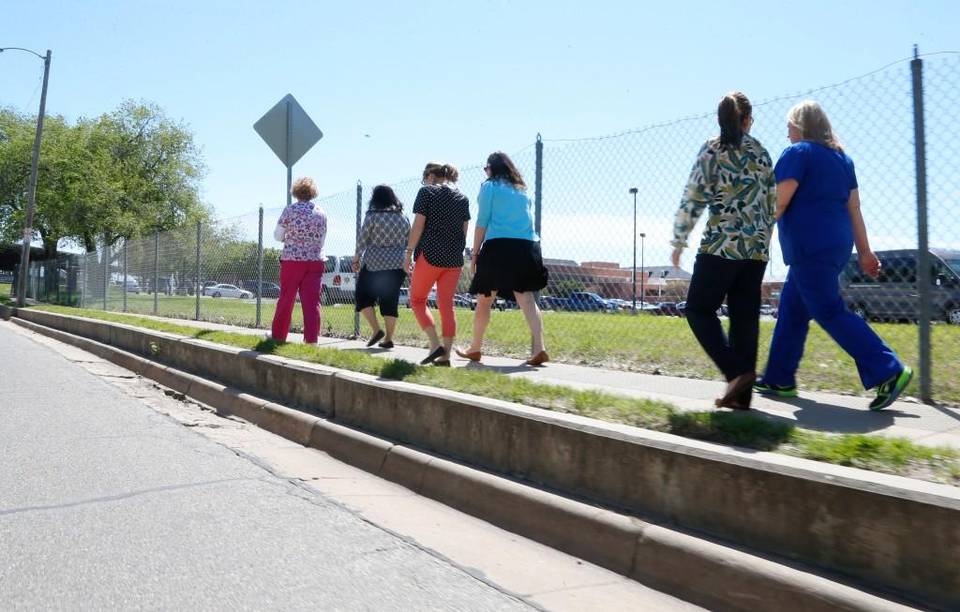Taking The First Steps: Walking Provides Multiple Health Benefits

Christina Monaghan and a number of fellow employees at the VA hospital get together to walk every day at noon. Usually covering around 2 miles. Bo Rader The Wichita Eagle
Christina Monaghan walks to improve her mood. Catherine Everingham is walking to get in shape for a multiday trek across the English moors.
Walking is one of the easiest and cheapest forms of exercise and prevention, and yet, it can be difficult to commit to putting one foot in front of the other. These two women can relate.
“The hardest step is the one out the front door,” Everingham said.
Last year both started taking a more disciplined approach to their wellness, making walking a central focus of their fitness regimen when they were selected to participate in the American Heart Association’s 12-week BetterU Challenge. The program promotes making healthy lifestyle changes.
Walking provides multiple health benefits, said a fitness expert and a cardiologist.
“There’s everything from improved mood and mental health to improved bone health, heart health and blood pressure and improved sleep patterns,” said Michael Rogers, professor and chair of Wichita State University’s human performance studies department who has researched fitness topics for more than 20 years. “It also helps prevent type 2 diabetes and heart disease.”
Dr. Shilpa Kshatriya, with Heartland Cardiology, agreed. Plus, she added, “people who walk tend to live longer, especially if you walk at a brisk pace,” which is one where you probably can’t sustain lengthy conversations.
Many fitness experts and health organizations, including the American Heart Association, recommend that adults get at least 10,000 steps a day. That equates to 5 miles, Rogers said.
Another target goal recommended by the American Heart Association and other health groups is 150 minutes of moderate exercise a week — walking falls into that category — or about 30 minutes five times a week to see health and prevention benefits. Only a third of Americans accomplish that, Kshatriya said.
“Whether your body mass index is 19 or 40, I recommend walking for everyone,” Kshatriya said. She also recommends it for all ages, advising parents to model an activity like walking and include kids to help combat the growing problem of childhood obesity.
Setting the tone
Monaghan, a pharmacist, has been on the wellness committee at her workplace, the Robert J. Dole VA Medical Center, for five years. But she hadn’t been as dedicated as she needed or wanted to be to her own wellness. She and her husband, Sean, had become busy with a growing family. Then, their second child, Nathaniel, was diagnosed with leukemia at 5 months. He died at 15 months in May 2015.
“Walking has really helped me with that,” said Monaghan, 40. “Sometimes even a 5-minute walk will help me.”
She starts every weekday with a 5 a.m. walk, either in her neighborhood or at a YMCA. Her target goal is to get half of the 10,000 recommended daily steps in that morning walk and get the rest during morning, afternoon and lunch breaks at work. She keeps track of her steps with an app on her iPhone.
“It really sets the tone for the day,” Monaghan said. “It gets my endorphins going and I’m ready for the day. It was hard to get into, but I told myself, ‘If I want to improve, this is what I have to do.’”
At work, her walks are a chance to lead by example as a member of the wellness committee, she said. Sometimes she invites a co-worker or two to walk and sometimes others just join in. She likes the social aspect of those walks, she said.
More mileage
Everingham, a Valley Center resident, had been walking 2 miles a day for years. But she felt she wasn’t in the shape she needed to be. She was getting stagnant with her walking program, plus she wanted to lose weight.
After going through the BetterU Challenge, which reinforced walking as a good habit, she decided to motivate herself with a goal: to retrace part of what is known as the Coast to Coast trail she and her husband, Doug, had biked across in England in 1979.
“This is going to be my dream walk,” she said.
To prepare for the upcoming eight-day trek across the Yorkshire moors from the village of Reeth to Robin Hood’s Bay — that will require covering between 9 and 16 miles each day — she has upped her daily walking goal. She has been able to walk as many as 8 miles in one day.
“From my house in rural Valley Center to the Park City Pizza Hut it’s 4 miles one way,” she noted. Generally she walks 6 miles a day outdoors, rain or shine and even in the dark. Her neighbor Carol Eakin often joins her, helping keep her committed to her regimen.
The increased mileage has helped her lose 20 pounds, has decreased her body mass index, and has helped regulate her sleep and eating patterns, she said. “When you’re walking, you can’t have your hand in the cookie jar,” she said.
A violin teacher with Senseney Music and Newman University, as well as a private piano tutor, Everingham keeps pace with a metronome app on her phone: a relaxed walk is 114 beats per minute, while a jog is 189 for her.
Story Credit: http://www.kansas.com/living/health-fitness/article147496344.html


